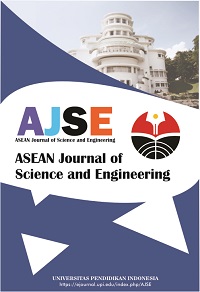The Effectiveness of Mugwort Leaf Extract and Gotu Kola Leaf Extract against Acne Bacterial Activity
Abstract
Acne is a problem among teenagers generally caused by bacterial infections such as Propionibacterium acnes, Staphylococcus aureus, and Staphylococcus epidermidis. Mugwort (Artemisia vulgaris L.) and Gotu Kola (Centella asiatica L.) extracts have antibacterial activity formulated in anti-acne gel preparations. The purpose of this study was to test and obtain a gel formula of mugwort leaf extract and gotu kola leaf extract which effectively kills and controls the growth of acne-causing bacteria. The methods used in this study include simplicity making, leaf extraction, making anti-acne gel preparations, testing pH, homogeneity, inhibition, and data analysis. The extract obtained by maceration was made in three concentrations, namely 2.50; 5.00; and 10.00%. The results showed that the pH value of the gel preparations obtained was in the range of 8.08-9.96. Mugwort leaf extract, gotu kola leaf, and mugwort-gotu kola have a distinctive smells with a thick texture at a concentration of 2.50% and a liquid texture at a concentration of 10.00%. Inhibition tests showed that the mugwort extract sample had a value of 16-18 mm, while the gotu kola extract and mugwort-gotu kola had a value of >14 mm. Mugwort leaf extract is able to inhibit the growth of acne-causing bacteria. This success was obtained because the extracts of mugwort and gotu kola leaves contain flavonoids that can inhibit the growth of bacteria that cause acne. Mugwort leaf extract gel with a concentration of 2.50 and 5.00% had the largest zone of inhibition in inhibiting P. acnes bacteria compared to other concentrations.
Keywords
Full Text:
PDFReferences
Anggraini, D., Rahmawati, N., and Hafsah, S. (2013). Formulasi gel anti jerawat dari ekstrak etil asetat gambir. Penelitian Farmasi Indonesia, 1(2), 62-66.
Anggraini, P. R. N., Ciawi, Y., and Rahayu, M. R. (2019). Potensi campuran ekstrak etanol pegagan (Centella asiatica) dan paspasan (Coccinia grandis) dengan aroma teh hijau sebagai obat jerawat. Jurnal Widya Biologi, 10(02), 76-86.
Budi, S., and Rahmawati, M. (2019). Pengembangan formula gel ekstrak pegagan (Centella asiatica (L.) urb) sebagai anti jerawat. Jurnal Farmasi dan Ilmu Kefarmasian Indonesia, 6(1), 51-55.
Ekiert, H., Pajor, J., Klin, P., Rzepiela, A., Ślesak, H., and Szopa, A. (2020). Significance of Artemisia vulgaris L. (common mugwort) in the history of medicine and its possible contemporary applications substantiated by phytochemical and pharmacological studies. Molecules, 25(19), 1-32.
Guay, D. R. P. (2007). Topical clindamycin in the management of acne vulgaris. Expert Opinion on Pharmacotherapy, 8(15), 2625-2664.
Lynn, D. D., Umari, T., Caori, A. D., and Robert, P. D. (2016). The epidemiology of acne vulgaris in late adolescence. Adolescent Health Medicine and Therapeutics, 7(2016), 13-25.
Mappa, T., Edy, H. J., and Kojong, N. (2013). Formulasi gel ekstrak daun sasaladahan (Peperomia pellucida (L.) HBK) dan uji efektivitasnya terhadap luka bakar pada kelinci (Oryctolagus cuniculus). Pharmacon, 2(2), 49-55.
Park, E. J., and Oh, J. H. (2019). Antimicrobial activities of korean mugwort (Artemisia iwayomogi and Artemisia princeps) extracts against Staphylococcus aureus and Cutibacterium acnes. Korean Journal of Food Preservation, 26(4), 381-390.
Primastuti, R. F. (2013). Antioxidant and cytotoxic activities of Centella asiatica L. leaves and extract of green coffee beans in a cream preparation for grade 1- 3 cellulite and slimming. Makara Journal Sains, 17(2013), 1-5.
Purwaningdyah, R. A. K., and Nelva, K. J. (2013). Profil penderita akne vulgaris pada siswa-siswi di SMA Shafiyyatul Amaliyyah Medan. EJournal FK USU, 1(1), 1-8.
Putra, R.E.D., Homenta, H., and Wowor, V.N.S. (2017). Uji daya hambat perasan jeruk purut Citrus hytrix terhadap bakteri Staphylococcus aureus secara in vitro. Jurnal Ilmiah Farmasi, 6(1), 65-66.
Riasari, J. R., Sudarwanto, M. B., Indrawati, A., Latif, H., Krisnan, N. R., and Pisestiyani, H. (2020). Resistensi Enterobacteriaceae terhadap antibiotik asal sisa makanan dari sampah pesawat di Bandara Internasional Soekarno Hatta. Acta Veterinaria Indonesiana, 8(1), 47-54.
Sholih, M. G., Ahmad, M., and Siti, S. (2015). Rasionalitas penggunaan antibiotik di salah satu rumah sakit umum di Bandung tahun 2010. Jurnal Farmasi Klinik Indonesia, 4(1), 63-70.
Sikareepaisan, P., Suksamrarn, A., and Supaphol, P. (2008). Electrospun gelatin fiber mats containing a herbal Centella asiatica extract and release characteristics of asiaticoside. Nanotechnology, 19(1), 1-10.
Soetjipto, H., Elok, B. E., and Linawati, L. (2019). Pengaruh berbagai metoda penyulingan terhadap komponen penyusun minyak atsiri tanaman baru cina (Artemisia vulgaris L.) serta efek antibakterinya. Jurnal Penelitian Saintek, 19(2), 75-83.
Sun, F. J., Chen, L., and Sun, W. G. (2011). Study on microwave method extraction mugwort pigment and antibacterial performance. Wool Textile Journal, 39(2011), 17-19.
Thangjam, N. M., Taijong, J., and Kumar, A. (2020). Phytochemical and pharmacological activities of methanol extract of Artemisia vulgaris L. leaves. Clinical Phytoscience, 6(1), 1-8.
DOI: https://doi.org/10.17509/ajse.v2i3.39634
Refbacks
- There are currently no refbacks.
Copyright (c) 1970 Universitas Pendidikan Indonesia

This work is licensed under a Creative Commons Attribution-ShareAlike 4.0 International License.












